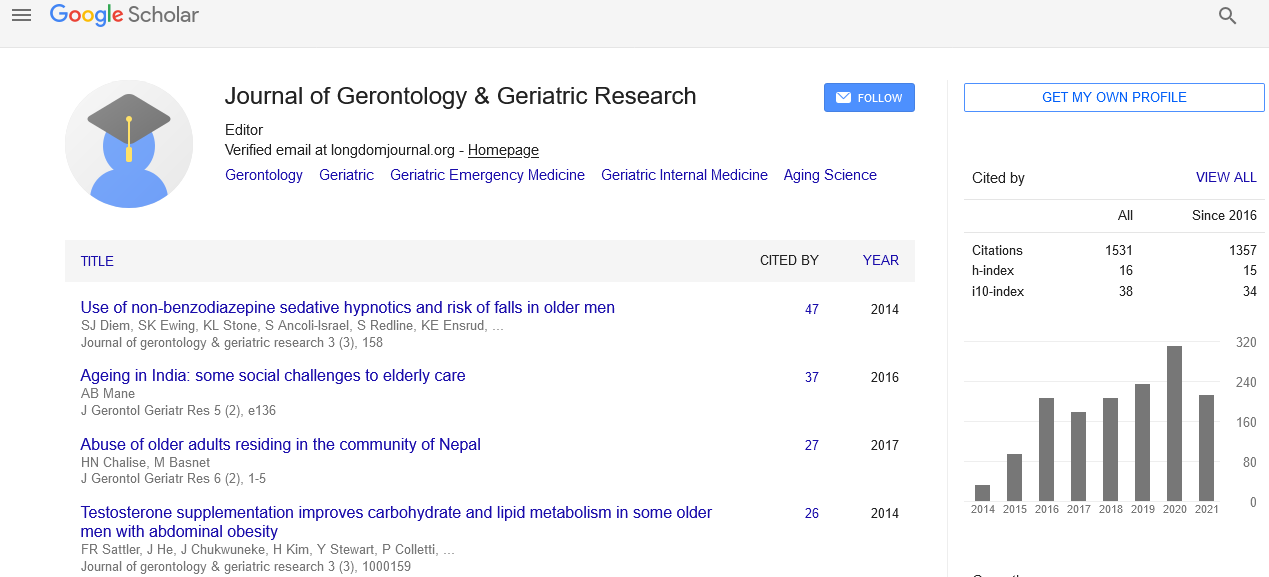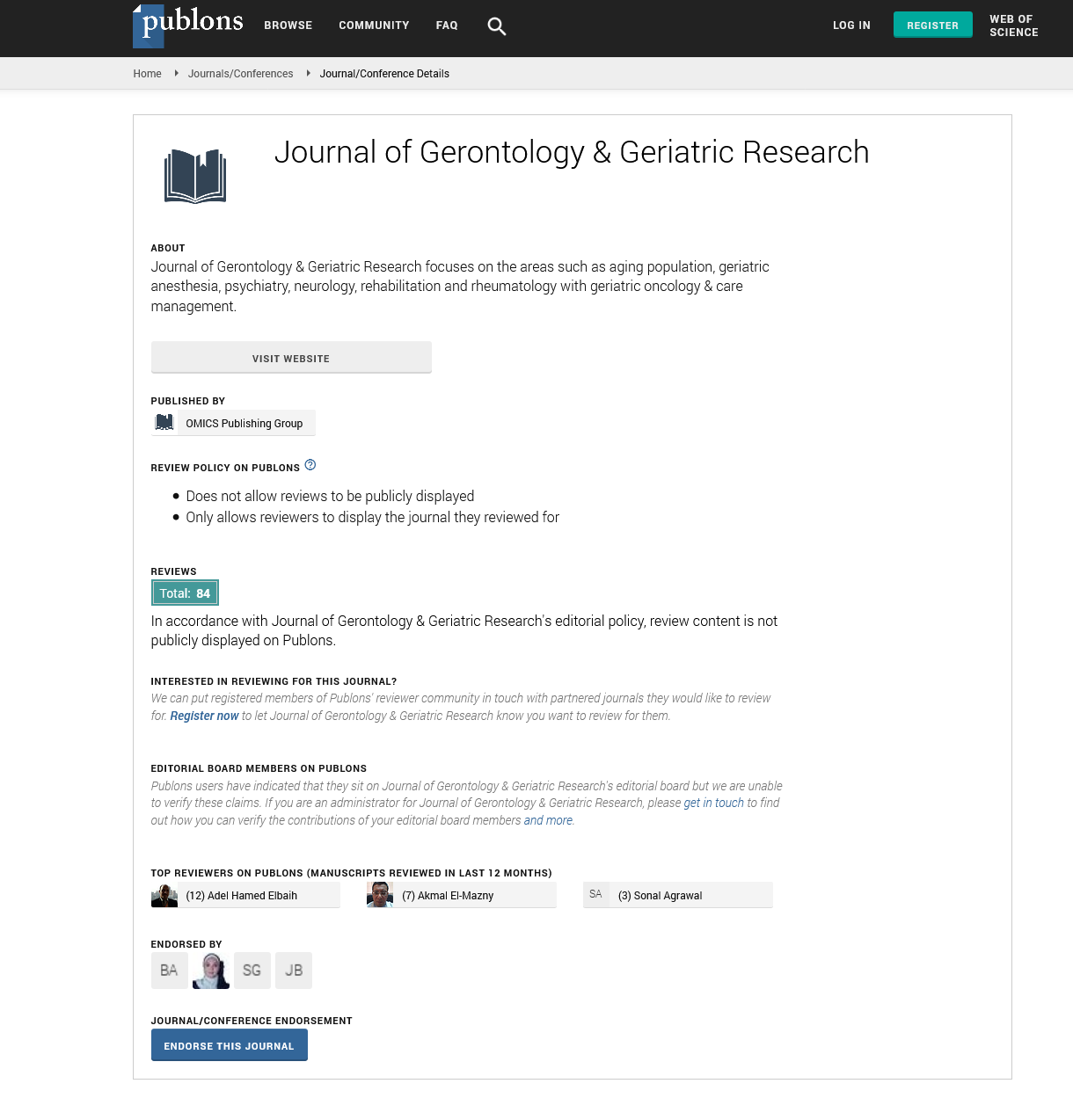PMC/PubMed Indexed Articles
Indexed In
- Open J Gate
- Genamics JournalSeek
- SafetyLit
- RefSeek
- Hamdard University
- EBSCO A-Z
- OCLC- WorldCat
- Publons
- Geneva Foundation for Medical Education and Research
- Euro Pub
- Google Scholar
Useful Links
Share This Page
Journal Flyer

Open Access Journals
- Agri and Aquaculture
- Biochemistry
- Bioinformatics & Systems Biology
- Business & Management
- Chemistry
- Clinical Sciences
- Engineering
- Food & Nutrition
- General Science
- Genetics & Molecular Biology
- Immunology & Microbiology
- Medical Sciences
- Neuroscience & Psychology
- Nursing & Health Care
- Pharmaceutical Sciences
Mini Review - (2023) Volume 12, Issue 4
Exploring Non-pharmacological Interventions for Geriatric Depression
Saheed Fderinto*Received: 01-Aug-2023, Manuscript No. jggr-23-22785; Editor assigned: 03-Aug-2023, Pre QC No. P-22785; Reviewed: 16-Aug-2023, QC No. Q-22785; Revised: 21-Aug-2023, Manuscript No. R-22785; Published: 28-Aug-2023, DOI: 10.35248/2167-7182.2023.12.686
Abstract
Geriatric depression, also known as late-life depression, is a prevalent mental health issue among the elderly population. It is characterized by persistent feelings of sadness, hopelessness, and a loss of interest in previously enjoyed activities. Given the physiological changes, social isolation, and life transitions that often accompany aging, depression can significantly impact the quality of life for older adults. While pharmacological interventions have been the traditional approach to treating depression, non-pharmacological interventions are gaining recognition for their effectiveness and potential to improve the emotional well-being of geriatric individuals. This article delves into the exploration of non-pharmacological interventions for geriatric depression, highlighting various therapeutic approaches and their benefits.
Keywords
Geriatric populations; Healthcare; Depression
Introduction
Cognitive Behavioral Therapy is a widely recognized and researched psychological intervention for depression, which focuses on identifying and modifying negative thought patterns and behaviors. In the geriatric population, CBT can be adapted to address specific challenges such as grief over losses, health concerns, and social isolation. It equips older adults with coping skills to manage depressive symptoms and prevent relapse. Problem- Solving Therapy is a structured approach that aims to enhance an individual's problem-solving skills. It is particularly relevant for geriatric depression as it assists older adults in identifying practical solutions to the challenges they face, reducing feelings of helplessness and improving their ability to manage stressors effectively. IPT focuses on improving interpersonal relationships and communication skills. In the context of geriatric depression, it can help address the loneliness and isolation often experienced by older adults. By working on enhancing social interactions and addressing unresolved conflicts, IPT can contribute to alleviating depressive symptoms. Reminiscence therapy involves discussing past experiences and memories as a therapeutic technique. For older adults, this can provide a sense of validation and purpose, fostering connections with their personal history and boosting selfesteem. By engaging in guided reminiscence, individuals can find joy in reliving positive memories and strengthening their sense of identity.
Literature Review
Physical activity and exercise have been linked to improved mental health across all age groups. In the geriatric population, regular exercise can help alleviate depression by increasing the release of endorphins, reducing inflammation, and improving overall well-being. Activities like walking, yoga, and tai chi can be particularly beneficial for older adults.
Interactions with animals, known as pet therapy or animalassisted therapy, can have a positive impact on mental health. The companionship of pets can reduce feelings of loneliness and provide a source of joy and responsibility. Spending time with animals has been shown to release oxytocin and decrease cortisol levels, contributing to stress reduction. Engaging in volunteer activities and maintaining social connections can be instrumental in combating geriatric depression. Meaningful social interactions and a sense of purpose gained from helping others can boost self-esteem and provide a more positive outlook on life. Creating an environment that supports mental well-being is essential for older adults. This can involve optimizing lighting, incorporating soothing colors, and ensuring a comfortable and safe living space. An improved living environment can positively influence mood and contribute to overall emotional health.
Discussion
Individual Variability: Older adults are a diverse group with varying needs, preferences, and levels of cognitive and physical functioning. Tailoring interventions to meet individual requirements is essential for their success.
Cultural factors play a significant role in how individuals perceive and engage with therapeutic interventions. It's crucial to consider cultural norms and beliefs when designing and implementing non-pharmacological approaches. Some older adults might be resistant to seeking help for depression due to stigma surrounding mental health issues. Raising awareness and reducing stigma within both the older population and society at large is important to encourage participation in non-pharmacological interventions. Access to mental health services can be limited for older adults, especially in rural or underserved areas. Efforts should be made to improve accessibility and provide resources for those who may not have easy access to these interventions. Geriatric individuals often have various medical conditions and may be taking multiple medications. It's important to consider potential interactions between interventions and medications, as well as any physical limitations that may affect participation. Maintaining the effects of non-pharmacological interventions over the long term can be challenging. Strategies for ongoing support and follow-up are necessary to prevent relapse and sustain the benefits gained from these interventions. In many cases, caregivers play a crucial role in the lives of older adults. Involving caregivers in the intervention [1].
More research is needed to directly compare the effectiveness of different non-pharmacological interventions. Understanding which interventions work best for specific individuals or subgroups can guide treatment recommendations. Integration with Pharmacological Treatments: Exploring the synergies between non-pharmacological and pharmacological treatments could lead to more comprehensive and personalized approaches to geriatric depression. With the advancement of technology, digital platforms and telehealth can be used to deliver non-pharmacological interventions, making them more accessible and convenient for older adults. Neurobiological Mechanisms: Further investigation into the neurobiological mechanisms underlying the effects of non-pharmacological interventions can provide insights into how these interventions impact brain function and contribute to mood improvement. Studying the long-term effects of nonpharmacological interventions can shed light on their sustainability and the potential for preventing recurrence of depressive episodes [2].
Healthcare Providers' Role: Physicians, psychologists, and other healthcare providers should receive training in geriatric mental health. This includes understanding the unique needs of older adults, recognizing symptoms of depression, and being knowledgeable about various non-pharmacological interventions. An integrated approach involving collaboration between medical professionals, mental health experts, and caregivers can ensure that the individual's physical, emotional, and social needs are addressed comprehensively. Raising awareness about the prevalence of geriatric depression and the effectiveness of non-pharmacological interventions is vital. Educational campaigns can help reduce stigma, encourage help-seeking behavior, and empower older adults to engage in these interventions. The identification of genetic pathways and specific genes involved in aging opens up the possibility of developing pharmacological interventions to target these pathways. Researchers are actively investigating compounds that can modulate these pathways, such as senolytics that selectively eliminate senescent cells, or drugs that mimic the effects of caloric restriction or activate sirtuins. These interventions aim to slow down the aging process, delay the onset of age-related diseases, and ultimately extend healthy lifespan. While much more research is needed to validate the safety and efficacy of these interventions in humans, the potential is promising [3].
Community centers, senior living facilities, and local organizations can offer spaces for group therapy sessions, creative workshops, and physical activity classes. Creating a supportive environment that encourages participation can significantly enhance the impact of these interventions. Caregivers, including family members and professional caregivers, should be educated about the importance of non-pharmacological interventions and how to support older adults in engaging with these activities. Onpharmacological interventions should be tailored to individual preferences and needs. This might involve assessing an individual's interests, physical capabilities, and cultural background to create a personalized intervention plan. Regular assessment of depressive symptoms and overall well-being can help track the progress of the interventions. Outcome measures can guide adjustments to the intervention plan as needed. As digital platforms become more prevalent, integrating technology into non-pharmacological interventions can enhance accessibility and engagement, particularly for those who are unable to attend in-person sessions [4].
Engaging in meaningful activities, building social connections, and gaining a sense of purpose can significantly improve an individual's overall quality of life. Many interventions, such as cognitive training and creative therapies; have the potential to improve cognitive function and memory, which are important for maintaining independence in older age. Interventions like exercise and mindfulness not only improve mental health but also have positive effects on physical health, such as cardiovascular fitness, immune function, and pain management. Effective nonpharmacological interventions can lead to reduced healthcare utilization by preventing or managing depressive episodes, thereby decreasing hospitalizations and medical interventions [5].
As the field of longevity and genetics advances, ethical considerations come into play. The prospect of extending human lifespan raises questions about resource allocation, social inequality, and the impact on population dynamics. It is crucial to navigate these ethical considerations thoughtfully and ensure that the benefits of lifespan extension are accessible to all, promoting equitable and inclusive approaches to healthy aging [6].
Conclusion
Geriatric depression poses a significant challenge to the wellbeing of older adults, but non-pharmacological interventions offer a promising avenue for improving mental health without solely relying on medication. By embracing a holistic approach that considers individual needs, preferences, and the unique challenges faced by older adults, society can empower this population to engage in activities that foster emotional well-being and overall life satisfaction. Through continued research, education, and collaboration between healthcare providers, caregivers, and the community, non-pharmacological interventions can become an integral part of geriatric mental health care. By addressing the multifaceted nature of depression in older adults, these interventions not only alleviate symptoms but also contribute to a more vibrant and fulfilling life in the later years. As we move forward, prioritizing and investing in these interventions can lead to a brighter and healthier future for the aging population.
Acknowledgement
None.
Conflict of Interest
None.
References
- Hinton DR, Sadun AA, Blanks JC, Miller CA. Optic-nerve degeneration in Alzheimer's disease. N Engl J Med 1986; 315:485-487.
- Blanks JC, Schmidt SY, Torigoe Y, Porrello KV, Hinton DR, Blanks RH. Retinal pathology in Alzheimer's disease. II. Regional neuron loss and glial changes in GCL. Neurobiol Aging1996; 17:385-95.
- Pan J, Bonow RH, Temkin N, Robinson EF, Sekhar LN, Levitt MR, et al. Incidence and risk model of venous thromboembolism in patients with aneurysmal subarachnoid hemorrhage. World Neurosurg 2023; 172:418-27.
- Zuin M, Barco S, Giannakoulas G, Engelen MM, Hobohm L, Valerio L, et al. Risk of venous thromboembolic events after COVID-19 infection: A systematic review and meta-analysis. J Thromb Thrombolysis 2023:1-9.
- Raptis DG, Gourgoulianis KI, Daniil Z, Malli F. Time trends for pulmonary embolism incidence in Greece. Thromb J 2020; 18:1-9.
- Nasser MF, Jabri A, Sharma S, Alhuneafat L, Omar YA, Krishnan V, et al. Outcomes with use of extra-corporeal membrane oxygenation in high-risk pulmonary embolism: A national database perspective. J Thromb Thrombolysis 2023:1-7.
Google Scholar, Crossref, Indexed at
Google Scholar, Crossref, Indexed at
Google Scholar, Crossref, Indexed at
Google Scholar, Crossref, Indexed at
Google Scholar, Crossref, Indexed at
Citation: Fderinto S (2023) Exploring Non-pharmacological Interventions for Geriatric Depression. J Gerontol Geriatr Res. 12: 686.
Copyright: © 2023 Fderinto S. This is an open-access article distributed under the terms of the Creative Commons Attribution License, which permits unrestricted use, distribution, and reproduction in any medium, provided the original author and source are credited.


